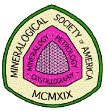Asbestos
Accepted November 17, 2011; reaffirmed 18 October 2014; up for review Fall, 2019
The solid surface of our Earth is formed of rocks, sediment, and soil, which in turn are composed predominantly of minerals. There are approximately 5,000 different minerals on Earth, each of which has a distinct chemical composition and arrangement of atoms that impart physical and chemical properties and make it unique. Those minerals that can be separated lengthwise into fibers are said to have an asbestiform habit. Different asbestiform minerals have different compositions, atomic arrangements, and physical and chemical properties.
Asbestos is not the name of a mineral. It is an industrial term used for a group of silicate minerals that occur as fibers with a characteristic set of physical properties that typically includes a high tensile strength and resistance to heat and friction. It has been demonstrated that occupational exposure to asbestos can cause a series of asbestos-related diseases. However, these different health effects depend on the particular mineral(s) that forms the asbestos. It is thus incorrect to treat different types of asbestos as identical for purposes of regulation. We urge all those concerned with asbestos issues to consider the particular mineral(s) in question.
The definition of the term "fiber" differs between the mineralogical and regulatory communities, and even differs as a function of the instrumentation used to monitor asbestos in the workplace. Mineralogists use a morphological definition (a thread or filament), whereas regulators typically use a particle’s aspect ratio. For example, one regulatory method would count a particle as a fiber if the particle is three times longer than it is wide. On the basis of either definition, mineral fibers occur throughout Nature and are found in rocks, sediment, soils, and the atmosphere. Most soils and rocks contain at least some minerals with a 3:1 aspect ratio. If the regulatory definition for occupational settings was applied in Nature, then most rocks and soils would contain regulated fibers. Indeed, if all minerals that occur with a 3:1 aspect ratio were dangerous, there would be no safe place on Earth. Clearly, this is not the case. We urge all those concerned with asbestos not to equate natural occurrences of mineral fibers, defined by regulatory criteria, with occupational exposure to asbestos.
Science-based mineral information should be used to guide the development of practices and laws that protect workers and the general public from the risks of asbestos exposure. Mineral information also should be used to reduce concerns that all mineral fibers are the same and to avoid unnecessary regulation, expense, and fear. Scientific societies that are focused on the mineral sciences, such as the Mineralogical Society of America (MSA), should be used as resources for those balancing asbestos concerns. Mineralogists, who are trained to identify and characterize minerals, should provide their expertise to those responsible for regulation of mineral species. Cooperation of regulatory agencies and mineralogists on asbestos policies should lead to policies that appropriately and accurately balance worker safety, public health, and economic development.

MSA Policy Statements
Accepted Policy Statements
Preservation of Natural History Collections: Minerals and Rocks
Proposed Policy Statements open for comments
To propose a Policy Statement or comment on a Policy Statement during its comment period, contact:
Mineralogical Society of America
3635 Concorde Pkwy Ste 500
Chantilly VA 20151-1125 USA
Tel: +1 (703) 652-9950
Fax: +1 (703) 652-9951
E-mail: aspeer@minsocam.org
Did you use a MSA Policy Statement? Tell us how.